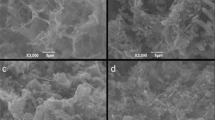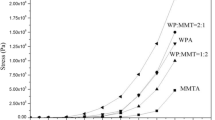Abstract
Besides excellent adsorption performance of adsorbents, the disposal of spent adsorbents should be considered for environmental concern. In this study, a new all-biomass double network Jute/sodium alginate (Jute/SA) gel is prepared via the simple dripping technique. 80 wt% water of Jute/SA hydrogel endows the adsorbent with high permeability for heavy metal ions diffusion onto internal adsorption sites. The Jute/SA gel adsorbent can efficiently remove heavy metals from melting wastewater, especially Pb2+ and Cd2+. The adsorbent shows high adsorption capacities of 291.3 mg g−1 for Pb2+ and 149.9 mg g−1 for Cd2+ at 298 K. The adsorption equilibrium reaches within 45 min for 45 mg L−1 Cd2+ and Pb2+ using 1 g L−1 adsorbent, showing 98% removal efficiency of Pb2+ and Cd2+. Moreover, the removal efficiencies in 45 min reach up to 99.1% for Pb2+ (7.539 mg L−1) and 89.9% for Cd2+ (4.743 mg L−1) in actual melting effluent containing Zn (43.95 mg L−1), Cu (16.50 mg L−1), Mn (19.24 mg L−1), Ni (4.90 mg L−1) and Fe (33.75 mg L−1) using 1 g L−1 adsorbent. The concentrations of Pb and Cd decrease below 0.001 mg L−1 using 4 g L−1 adsorbent. Furthermore, the adsorption efficiencies for Pb2+ and Cd2+ remain above 95% in the tenth cycle, and the desorption efficiency is up to 99%. In addition, the spent Jute/SA gel was a good organic fertilizer for plant growth. This work develops an efficient and eco-friendly biomass adsorbent for the removal of heavy metals in actual wastewater.











Similar content being viewed by others
References
Liu Y, Xiao T, Baveye P, Zhu J, Ning Z, Li H (2015) Potential health risk in areas with high naturally-occurring cadmium background in southwestern China. Ecotoxicol Environ Saf 112:122–131
Uddin M (2017) A review on the adsorption of heavy metals by clay minerals, with special focus on the past decade. Chem Eng J 308:438–462
Shao P, Liang D, Yang L, Shi H, Xiong Z, Ding L, Yin X, Zhang K, Luo X (2020) Evaluating the adsorptivity of organo-functionalized silica nanoparticles towards heavy metals: quantitative comparison and mechanistic insight. J Hazard Mater 387:121676
Chitpong N, Husson S (2017) High-capacity, nanofiber-based ion-exchange membranes for the selective recovery of heavy metals from impaired waters. Sep Purif Technol 179:94–103
Ihsanullah A, Al-Amer A, Laoui T, Al-Marri M, Nasser M, Khraisheh M, Atieh M (2016) Heavy metal removal from aqueous solution by advanced carbon nanotubes: critical review of adsorption applications. Sep Purif Technol 157:141–161
Kyzas G, Bomis G, Kosheleva R, Efthimiadou E, Favvas E, Kostoglou M, Mitropoulos A (2019) Nanobubbles effect on heavy metal ions adsorption by activated carbon. Chem Eng J 356:91–97
Liu D, Li Z, Li W, Zhong Z, Xu J, Ren J, Ma Z (2013) Adsorption behavior of heavy metal ions from aqueous solution by soy protein hollow microspheres. Ind Eng Chem Res 52:11036–11044
Loganathan P, Shim W, Sounthararajah D, Kalaruban M, Nur T, Vigneswaran S (2018) Modelling equilibrium adsorption of single, binary, and ternary combinations of Cu, Pb, and Zn onto granular activated carbon. Environ Sci Pollut Res 25:16664–16675
Bumanis G, Novais R, Carvalheiras J, Bajare D, Labrincha J (2019) Metals removal from aqueous solutions by tailored porous waste-based granulated alkali-activated materials. Appl Clay Sci 179:105147
Shao P, Ding L, Luo J, Luo Y, You D, Zhang Q, Luo X (2019) Lattice-defect-enhanced adsorption of arsenic on zirconia nanospheres: A combined experimental and theoretical study. ACS Appl Mater Interfaces 11:29736–29745
Zhao G, Huang X, Tang Z, Huang Q, Niu F, Wang X (2018) Polymer-based nanocomposites for heavy metal ions removal from aqueous solution: a review. Polym Chem 9:3562–3582
Anastopoulos I, Robalds A, Nguyen Tran H, Mitrogiannis D, Giannakoudaki D, Hosseini-Bandegharaei A, Dotto G (2019) Removal of heavy metals by leaves-derived biosorbents. Environ Chem Lett 17:755–766
Lai Y, Chang Y, Chen M, Lo Y, Lai J, Lee D (2016) Poly(vinyl alcohol and alginate cross-linked matrix with immobilized Prussian blue and ion exchange resin for cesium removal from waters. Bioresour Technol 214:192–198
Zhou G, Luo J, Liu C, Chu L, Crittenden J (2018) Efficient heavy metal removal from industrial melting effluent using fixed-bed process based on porous hydrogel adsorbents. Water Res 131:246–254
Zhou G, Luo J, Liu C, Chu L, Ma J, Tang Y, Zeng Z, Luo S (2016) A highly efficient polyampholyte hydrogel sorbent based fixed-bed process for heavy metal removal in actual industrial effluent. Water Res 89:151–160
Rajamani M, Rajendrakumar K (2019) Chitosan-boehmite desiccant composite as a promising adsorbent towards heavy metal removal. J Environ Manag 244:257–264
Avetta P, Pensato A, Minella M, Malandrino M, Maurino V, Minero C, Hanna K, Vione D (2015) Activation of persulfate by irradiated magnetite: implications for the degradation of phenol under heterogeneous photo-fenton-like conditions. Environ Sci Technol 49:1043–1050
Mu B, Zhong W, Dong Y, Du P, Liu P (2012) Encapsulation of drug microparticles with self-assembled Fe3O4/alginate hybrid multilayers for targeted controlled release. J Biomed Mater Res B 100:825–831
Zhou G, Liu C, Chu L, Tang Y, Luo S (2016) Rapid and efficient treatment of wastewater with high-concentration heavy metals using a new type of hydrogel-based adsorption process. Bioresour Technol 219:451–457
Yang P, Zhao J, Zhang L, Li L, Zhu Z (2015) Intramolecular hydrogen bonds quench photoluminescence and enhance photocatalytic activity of carbon nanodots. Chem Eur J 21:8561–8568
Chu L, Liu C, Zhou G, Xu R, Tang Y, Zeng Z, Luo S (2015) A double network gel as low cost and easy recycle adsorbent: highly efficient removal of Cd(II) and Pb(II) pollutants from wastewater. J Hazard Mater 300:153–160
Hadi P, Barford J, McKay G (2013) Toxic heavy metal capture using a novel electronic waste-based material—mechanism, modeling and comparison. Environ Sci Technol 47:8248–8255
Petrus R, Warcho J (2005) Heavy metal removal by clinoptilolite. An equilibrium study in multi-component systems. Water Res 39:819–830
Phetphaisit C, Yuanyang S, Chaiyasith W (2016) Polyacrylamido-2-methyl-1-propane sulfonic acid-grafted-natural rubber as bio-adsorbent for heavy metal removal from aqueous standard solution and industrial wastewater. J Hazard Mater 301:163–171
Xu R, Zhou G, Tang Y, Chu L, Liu C, Zeng Z, Luo S (2015) New double network hydrogel adsorbent: highly efficient removal of Cd(II) and Mn(II) ions in aqueous solution. Chem Eng J 275:179–188
Zhu Y, Hu J, Wang J (2012) Competitive adsorption of Pb(II), Cu(II) and Zn(II) onto xanthate-modified magnetic chitosan. J Hazard Mater 221:155–161
Sounthararajah D, Loganathan P, Kandasamy J, Vigneswaran S (2015) Adsorptive removal of heavy metals from water using sodium titanate nanofibers loaded onto GAC in fixed-bed columns. J Hazard Mater 287:306–316
El-Toni A, Habila M, Ibrahim M, Labis J, ALOthman Z (2014) Simple and facile synthesis of amino functionalized hollow core-mesoporous shell silica spheres using anionic surfactant for Pb(II), Cd(II), and Zn(II) adsorption and recovery. Chem Eng J 251:441–451
Deng S, Wang P, Zhang G, Dou Y (2016) Polyacrylonitrile-based fiber modified with thiosemicarbazide by microwave irradiation and its adsorption behavior for Cd(II) and Pb(II). J Hazard Mater 307:64–72
Liang X, Xu Y, Sun G, Wang L, Sun Y, Sun Y, Qin X (2011) Preparation and characterization of mercapto functionalized sepiolite and their application for sorption of lead and cadmium. Chem Eng J 174:436–444
Liu D, Li Z, Zhu Y, Li Z, Kumar R (2014) Recycled chitosan nanofibril as an effective Cu(II), Pb(II) and Cd(II) ionic chelating agent: adsorption and desorption performance. Carbohydr Polym 111:469–476
Ding Y, Liu Y, Liu S, Li Z, Tan X, Huang X, Zeng G, Zhou Y, Zheng B, Cai X (2016) Competitive removal of Cd(II) and Pb(II) by biochars produced from water hyacinths: performance and mechanism. RSC Adv 6:5223–5232
Cataldo S, Gianguzza A, Merli M, Muratore N, Piazzese D, Liveri M (2014) Experimental and robust modeling approach for Pb(II) uptake by alginate gel beads: Influence of the ionic strength and medium composition. J Colloid Interface Sci 434:77–88
He J, Lu Y, Luo G (2014) Ca(II) imprinted chitosan microspheres: an effective and green adsorbent for the removal of Cu(II), Cd(II) and Pb(II) from aqueous solutions. Chem Eng J 244:202–208
Sangi M, Shahmoradi A, Zolgharnein J, Azimi G, Ghorbandboost M (2008) Removal and recovery of heavy metals from aqueous solution using Ulmus carpinifolia and Fraxinus excelsior tree leaves. J Hazard Mater 155:513–522
Zhou G, Liu C, Tang Y, Luo S, Zeng Z, Liu Y, Xu R, Chu L (2015) Sponge-like polysiloxane-graphene oxide gel as a highly efficient and renewable adsorbent for lead and cadmium metals removal from wastewater. Chem Eng J 280:275–282
Wu N, Li Z (2013) Synthesis and characterization of poly(HEA/MALA) hydrogel and its application in removal of heavy metal ions from water. Chem Eng J 215–216:894–902
Srivastava S, Agrawal S, Mondal M (2015) A review on progress of heavy metal removal using adsorbents of microbial and plant origin. Environ Sci Pollut Res 22:15386–15415
Acknowledgements
This work was supported by the National Natural Science Foundation of China (51778218), the Science and Technology Innovation Plan of Hunan Province (2019JJ10001, 2020JJ7036, 2017SK2420 and 2019RS3015) and Hunan Provincial Key Laboratory for Cost-effective Utilization of Fossil Fuel Aimed at Reducing Carbon-dioxide Emissions (HND2018005).
Author information
Authors and Affiliations
Corresponding authors
Additional information
Publisher's Note
Springer Nature remains neutral with regard to jurisdictional claims in published maps and institutional affiliations.
Rights and permissions
About this article
Cite this article
Wen, L., Zhang, Y., Liu, C. et al. All-Biomass Double Network Gel: Highly Efficient Removal of Pb2+ and Cd2+ in Wastewater and Utilization of Spent Adsorbents. J Polym Environ 28, 2669–2680 (2020). https://doi.org/10.1007/s10924-020-01806-8
Published:
Issue Date:
DOI: https://doi.org/10.1007/s10924-020-01806-8




